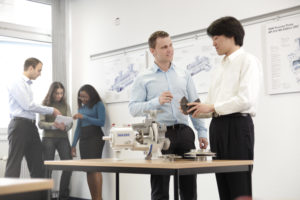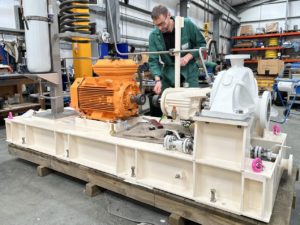International Symposium on Centrifugal Pumps
Centrifugal pumps have been around for centuries, so what’s new? Surprisingly, many significant improvements have taken place since we last reviewed this topic four years ago. So find out what's new on September 22, 2004 in London.

Improving Value in Pumping
Several experts in the fields of pumps and pumping will come together to discuss:
- Reducing costs by using less components and better seals, bearings and couplings, thus providing improved reliability, ease of repair and faster maintenance.
- Reducing costs by increasing and maintaining pump efficiency and by using integrated pump/motor units of variable speed.
- Reducing costs by using high speed super-synchronous motors to produce more compact units of greater reliability.
- Improving safety by secondary containment and improved monitoring, and improving design by using simulation methods.
This event will be invaluable to those involved with pumps and pumping, including makers and users, component suppliers, refurbishers, contractors, consultants and researchers. Find out:
- What to specify for best value
- How to reduce your operating costs
- What your competition is doing
- How to beat your competitors
Exhibition
The Symposium will be supported by an exhibition, and delegates will have the opportunity to meet representatives from the various companies during lunch and refreshment breaks.
Programme
22 September 2004
09.00
Registration and Coffee
09.30
Welcome and Introduction
SESSION 1: HYDRAULIC DESIGN – NEW RANGE DEVELOPMENT
Session Chair: George Aggidis, Lancaster University
09.35
Closed Valve Flow Field Investigation Using Computational Fluid Dynamics
Gary Dyson, David Brown Union Pumps
The flow field of a centrifugal pump operating at closed valve was investigated using Computational Fluid Dynamics (CFD). The rotor stator interactions were shown to directly link to the developed flow regime. The impeller flow regime was divided into two distinct areas. The upper proportion at the discharge vanes contained a vortex, influenced by the vanes. The lower proportion of the impeller was filled with a strong flow reversal. The suction duct flow regime contained a helically spiralling flow. The pump casing showed a non-linear pressure development around the volute influenced by the stationary collector.
09.55
A New Class of Sealless Pump with Synchronous Integrated Canned Magnetic Drive
Geoffrey Keen, HMD Sealless Pumps
This is a revolutionary new product, drawing on the best features of Mechanical Sealed Pumps, Canned Motor Pumps and Magnet Drive Pumps, to deliver a totally unique product. It combines the simplicity of design (and hence low cost of ownership) of a Magnet Drive Pump and the true secondary containment of a Canned Motor Pump. Described are the development of a unique high efficiency motor, a vapour detector that avoids pump failure, the use of silicon carbide bearings without any special alignment techniques, the achievement of certification for use in potentially explosive atmospheres and the use of existing components and manufacturing processes.
10.15
Development of a New Generation of Customer Focused Water Pumps
John Fleming, Weir Pumps Ltd
A radical product concept was followed in the development of a new generation of horizontal split casing industrial water pumps. This paper outlines the development process followed in establishing the hydraulic design base and enhanced performance. Focusing on customer benefits was critical, and was the catalyst to question and change aspects of the traditional mechanical design. The result is a product developed by a new design concept, using new technology, which delivers significant performance, manufacturing, maintenance and service benefits. The enhanced features of the single and two-stage products are presented against the comparable traditional product lines.
10.35
Discussion Session
11.05
Morning Coffee
SESSION 2: SECONDARY COMPONENTS
Session Chair: David Reeves, Pump Engineering Consultant
11.35
Improving Pump Reliability through its Secondary Components
Neil Wallace, Peter Bowden & John Evans, John Crane EAA
Pumps are critical items of rotating equipment in the process industries. Their failure can have huge consequences in terms of cost and safety. Pump reliability is, in turn, dependent on the performance of its principal secondary components such as seals, couplings and bearings. This paper looks at the influence of those components on overall pump reliability, sets targets for lifetimes and looks at ways of improving the performance of those secondary components. The paper includes case studies of real improvements as a result of applying new products and technologies, and working closely with the end user.
11.55
21st Century Bearing Protectors
Alan Roddis, AESSEAL plc
Bearing chamber sealing costs industry millions, if not billions of pounds each year. This paper compares the performance of commercially available bearing isolators under extreme conditions of a high velocity water jet, which simulates the in-service condition of leaking glands likely to give rise to serious reduction in bearing life. The Company decided to solve bearing chamber sealing with the use of a mechanical face seal, as recommended by API610 version 9 (Jan 2003).
The result was an innovative, patent pending, magnetically attracted ATEX Cat 2, dual face seal design, which is suitable for all types of pumps including centrifugal, horizontal and vertical.
12.15
Discussion Session
12.35
Lunch
SESSION 3: NEW DEVELOPMENTS
Session Chair: Robert Brown, Weir Pumps Ltd
13.35
Variable Medium Speed Pumps Combine Superior Performance with Reduced Life Cycle Cost
Christian Rossegger, Flowserve (Austria) GmbH
Flowserve’s new medium speed pump is a vertical inline single or two stage pump, running at speeds up to 8000 rpm. The pump is rigidly coupled to a high speed induction motor driven by a frequency converter. The variable frequency drive allows the pump to operate at variable speeds to meet different system characteristics. In many cases the flow control valve can be eliminated and a significant amount of energy is saved. Delivery of all components mounted in an electrical cabinet provides additional savings on installation costs. Moreover, control of main operating parameters results in higher reliability and longer maintenance intervals for the motor.
13.55
The Weir VSR 2100: A New Concept in High Pressure Pumping
Thomas Angle, Weir Speciality Pumps & Mike Turner, Switched Reluctance Drives Ltd
This pump represents a significant development in the field of high pressure pumping. A rotating case pitot tube pump has been integrated with a switched reluctance motor. The resulting unit is approximately 40% of the size of the system it replaces. The new pump eliminates the need for a gearbox, two couplings and field alignment. Other advantages include performance and efficiency improvements, improved reliability, energy savings by use of variable speed operation and grease lubricated bearings in the motor eliminating the need for oil lubricated bearings in the pump.
14.15
High Speed Pumps Using Integrated Motor Technology
John Veness, Sundyne Corporation
This paper discusses a radically new approach to pumping systems, which offers maximum flexibility, minimum power usage and maximum reliability. Sundyne has combined its experience in high-speed hydraulics, seals and bearings, with high-speed motor technology and sophisticated variable frequency electronic drives to create a radically different integrated pumping system. Due to the reduced number of primary components, the resulting package offers a higher degree of reliability not available with other technologies. The paper will present several of the technical challenges and advantages associated with the Anyspeed® pump, and a case study illustrating how this unique product solves a significant customer application problem.
14.35
Discussion Session
15.05
Afternoon Tea
SESSION 4: UPGRADES/ APPLICATIONS
Session Chair: Ron Palgrave, David Brown Union Pumps
15.35
Derby Transfer Pumping Station – Inception to Commissioning
Richard Evans, Severn Trent Water & Mike Hutchinson, ITT Flygt Ltd
Severn Trent Water constructed an inlet pumping station at Derby Sewage Works with a capacity of 6m3/s, which was required to overcome risks to the treatment process following failures of the old installation. This paper talks through the project, which went from conception in July 2001 to running trials just 12 months later in July 2002. The design and construction of the station utilised innovative and ground breaking approaches. These included two wet wells to segregate rags at the inlet and pass flows to treatment, high energy flow to keep material in suspension and valve chambers suspended over the wet wells to minimise footprint.
15.55
State-of-the-Art Boiler Feed Pump Upgrade for Ratcliffe Power Station
Brian Germaine and Gary Fitch, Sulzer Pumps & Chris Harris, Powergen
The existing main feed pump is a design originating from the early 1960's, intended for a base load 3 x 660MW power station. Under steady state, high load rating conditions, the pump cartridge can have an operational life of about 40,000 hours. Each generator must now work between about 180MW to 520MW, with the pumps operating at the best compromise of efficiency. The paper will discuss the need to upgrade, the hydraulic design and development activities, the state-of-the art mechanical design, and the extensive site work required on the old casings to accept a 21st century boiler feed pump cartridge. The pumps will be installed at site in June of this year.
16.15
Discussion
16.35
Closing Remarks
For more information, contact details and registration, please viste the IMechE web site.







